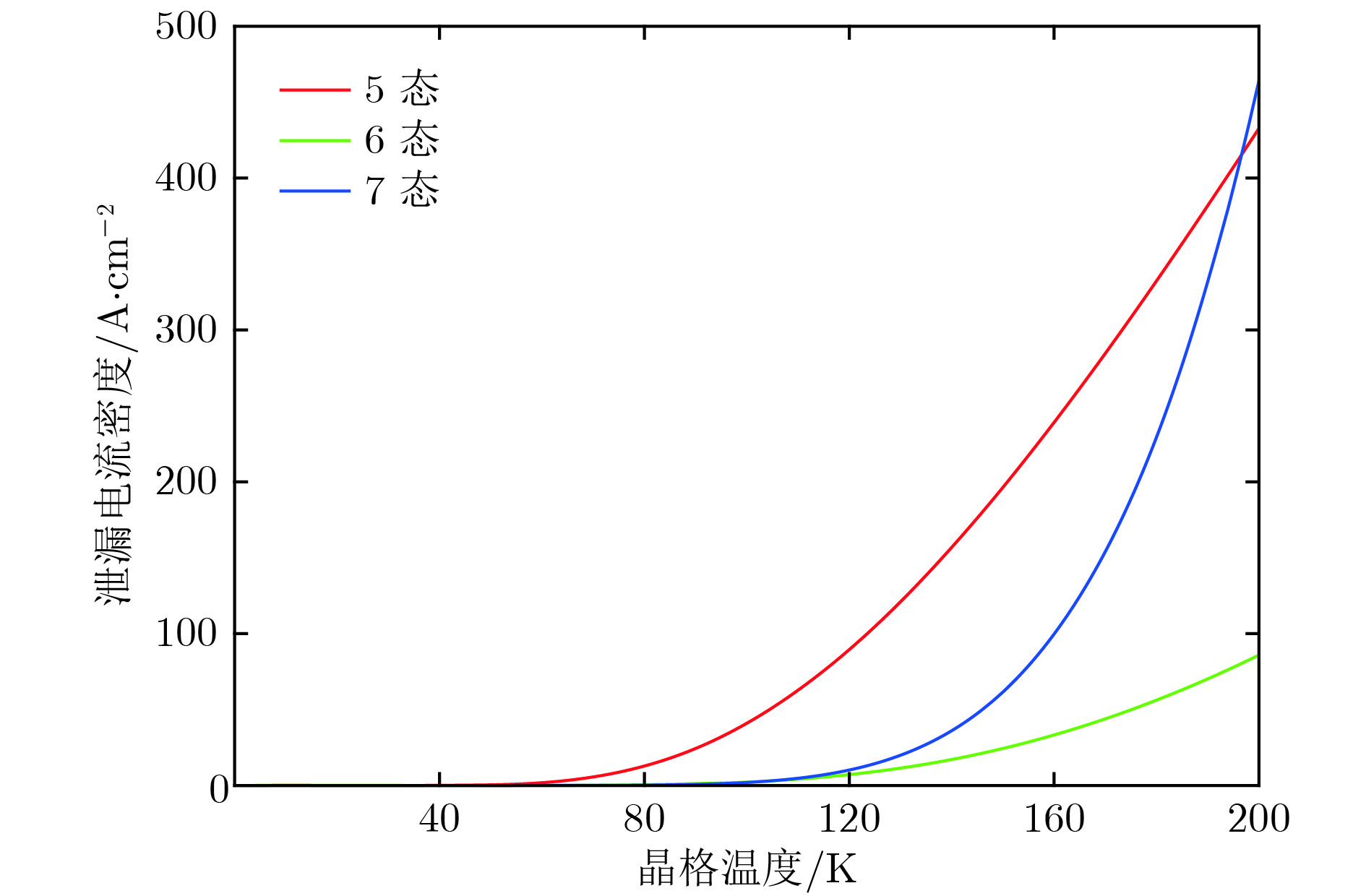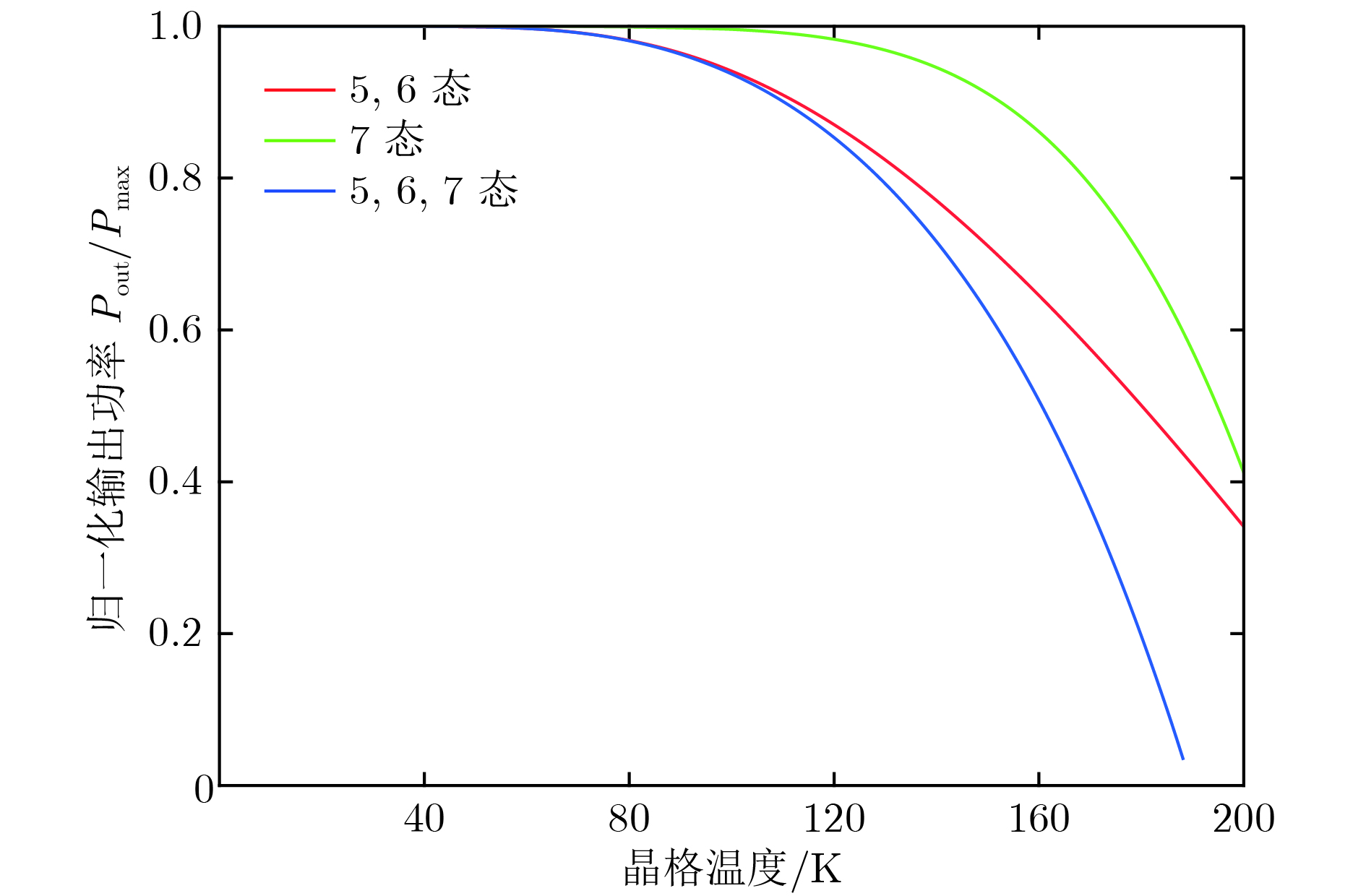-
利用热力学统计理论和激光器输出特性理论, 建立了太赫兹量子级联激光器(THz QCL)有源区中上激发态电子往更高能级电子态泄漏的计算模型, 以输出功率度量电子泄漏程度研究分析了晶格温度和量子阱势垒高度对电子泄漏的影响. 数值仿真结果表明, 晶格温度上升会加剧电子泄漏, 并且电子从上激发态泄漏到束缚态的数量大于泄漏到阱外连续态, 同时温度的上升也会降低激光输出功率. 增加量子阱势垒高度能抑制电子泄漏, 并且有源区量子阱结构中存在一个最优量子阱势垒高度. THz QCL经过最优量子阱势垒高度优化后, 工作温度得到提升, 其输出功率相比于以往的结果也有所提高. 研究结果对优化THz QCL有源区结构、抑制电子泄漏和改善激光器输出特性有指导作用.Terahertz quantum cascade laser is a semiconductor laser that effectively obtains terahertz waves. It uses the semiconductor heterojunction to have a quantum cascade effect under an applied voltage, and then the phonon assists the electron resonance from the upper stage to the next stage, so that a single electron injected externally can emit multiple photons. However, some electrons will deviate from the transport path during transportation and these electrons are called leakage electrons. Electron leakage comes from three ways. The first way is the scattering of electrons from the upper laser level through the long longitudinal phonon to the low energy level; the second way is the scattering of electrons from the lower laser level to the high energy bound level and the continuous level; and the third way is the scattering of electrons from the upper laser level to high energy bound levels and continuous levels. These leakage electrons directly reduce the number of population inversions in the laser system, making the laser output power limited. At present, most of researchers explain the electron leakage through indirect measurements, and there are few studies in which the electron leakage is analyzed by establishing theoretical models. In this paper, the electron leakage model in THz QCL is established by using thermodynamic statistical theory and laser output characteristic theory. The degree of electron leakage is measured by output power. The influence of lattice temperature and quantum well barrier height on electron leakage are studied. It is found that when the lattice temperature rises and the electrons in the upper laser state leak to higher energy levels, the number of electrons leaking to the adjacent bound state and the continuous state increases, and the number of electrons leaking to the next near-bound level is relatively small. In the case of electron leakage, the utilization of electrons becomes lowered, and the laser output power is also lowered. The study also shows that an appropriate increase in the height of the quantum barrier can suppress the leakage of electrons. Using the established theoretical model to optimize the quantum well barrier height of the previously reported laser system, an 8 mW terahertz quantum cascade laser (THz QCL) laser output at 210 K is obtained. Compared with the reported experimental results, the temperature and output power are improved. These results provide a theoretical basis for studying the electron leakage temperature characteristics of THz QCL and also optimally designing the THz QCL active region structure.
-
Keywords:
- terahertz /
- quantum cascade laser /
- electron leakage /
- active region
[1] 孙怡雯, 钟俊兰, 左剑, 张存林, 但果 2015 物理学报 64 169701
Sun Y W, Zhong J L, Zuo J, Zhang C L, Dan G 2015 Acta Phys. Sin. 64 169701
[2] Yardimci N T, Lu H, Jarrahi M 2016 Appl. Phys. Lett. 109 191103
 Google Scholar
Google Scholar
[3] 王珊, 王辅忠 2018 物理学报 67 160502
 Google Scholar
Google Scholar
Wang S, Wang F Z 2018 Acta Phys. Sin. 67 160502
 Google Scholar
Google Scholar
[4] Bing P B, Yao J Q, Xu D G, Xu X Y, Li Z Y 2010 Chin. Phys. Lett. 27 124209
 Google Scholar
Google Scholar
[5] 张真真 黎华 曹俊诚 2018 物理学报 67 090702
Zhang Z Z, Li H, Cao J C 2018 Acta Phys. Sin. 67 090702
[6] Zhang Z Z, Fu Z L, Guo X G, Cao J C 2018 Chin. Phys. B 27 030701
 Google Scholar
Google Scholar
[7] Köhler R, Tredicucci A, Beltram F, Beere H E, Linfield E H, Davies A G, Ritchie D A, Iotti R C, Rossi F 2002 Nature 417 156
 Google Scholar
Google Scholar
[8] Ravaro M, Gellie P, Santarelli G, Manquest C, Filloux P, Sirtori C, Jean-Francois, Ferrari G, Khanna S P, Linfield E H 2013 IEEE J. Sel. Top. Quantum Electron. 19 8501011
 Google Scholar
Google Scholar
[9] Fathololoumi S, Dupont E, Chan C, Wasilewski Z, Laframboise S, Ban D, Matyas A, Jirauschek C, Hu Q, Liu H C 2012 Opt. Express 20 3866
 Google Scholar
Google Scholar
[10] Li L, Liu F Q, Shao Y, Liu J Q, Wang Z G 2007 Chin. Phys. Lett. 24 1577
 Google Scholar
Google Scholar
[11] Albo A, Hu Q 2015 Appl. Phys. Lett. 107 241101
 Google Scholar
Google Scholar
[12] Albo A, Hu Q, Reno J L 2016 Appl. Phys. Lett. 109 081102
 Google Scholar
Google Scholar
[13] Krüger O, Kreutzmann S, Prasai D, Wienold M, Sharma R, Pittro W, Weixelbaum L, John W, Biermann K, Schrottke L 2013 IEEE Photon. Technol. Lett. 25 1570
 Google Scholar
Google Scholar
[14] Lin T T, Wang L, Wang K, Grange T, Hirayama H 2018 Appl. Phys. Express 11 112702
 Google Scholar
Google Scholar
[15] Monastyrskyi G, Elagin M, Klinkmüller M, Aleksandrova A, Kurlov S, Flores Y V, Kischkat J, Semtsiv M P, Masselink W T 2013 J. Appl. Phys. 113 134509
 Google Scholar
Google Scholar
[16] Flores Y V, Semtsiv M P, Elagin M, Monastyrskyi G, Kurlov S, Aleksandrova A, Kischkat J, Masselink W T 2013 J. Appl. Phys. 113 134506
 Google Scholar
Google Scholar
[17] Kumar S, Hu Q, Reno J L 2009 Appl. Phys. Lett. 94 131105
 Google Scholar
Google Scholar
[18] Albo A, Hu Q 2015 Appl. Phys. Lett. 106 131108
 Google Scholar
Google Scholar
[19] Kumar S, Chan C W I, Hu Q, Reno J L 2011 Nature Phys. 7 166
 Google Scholar
Google Scholar
[20] Harrison P, Indjin D, Kelsall R W 2002 J. Appl. Phys. 92 6921
 Google Scholar
Google Scholar
[21] Spagnolo V, Scamarcio G, Page H, Sirtori C 2004 Appl. Phys. Lett. 84 3690
 Google Scholar
Google Scholar
[22] Schneider H, Klitzing K V 1988 Phys. Rev. B 38 6160
 Google Scholar
Google Scholar
[23] Faist J 2013 Quantum Cascade Lasers (Oxford: Oxford University Press) pp72−73
[24] Bhattacharya I, Chan C W I, Hu Q 2012 Appl. Phys. Lett. 100 011108
 Google Scholar
Google Scholar
[25] Botez D, Chang C C, Mawst L J 2016 J. Phys. D 49 043001
 Google Scholar
Google Scholar
-
[1] 孙怡雯, 钟俊兰, 左剑, 张存林, 但果 2015 物理学报 64 169701
Sun Y W, Zhong J L, Zuo J, Zhang C L, Dan G 2015 Acta Phys. Sin. 64 169701
[2] Yardimci N T, Lu H, Jarrahi M 2016 Appl. Phys. Lett. 109 191103
 Google Scholar
Google Scholar
[3] 王珊, 王辅忠 2018 物理学报 67 160502
 Google Scholar
Google Scholar
Wang S, Wang F Z 2018 Acta Phys. Sin. 67 160502
 Google Scholar
Google Scholar
[4] Bing P B, Yao J Q, Xu D G, Xu X Y, Li Z Y 2010 Chin. Phys. Lett. 27 124209
 Google Scholar
Google Scholar
[5] 张真真 黎华 曹俊诚 2018 物理学报 67 090702
Zhang Z Z, Li H, Cao J C 2018 Acta Phys. Sin. 67 090702
[6] Zhang Z Z, Fu Z L, Guo X G, Cao J C 2018 Chin. Phys. B 27 030701
 Google Scholar
Google Scholar
[7] Köhler R, Tredicucci A, Beltram F, Beere H E, Linfield E H, Davies A G, Ritchie D A, Iotti R C, Rossi F 2002 Nature 417 156
 Google Scholar
Google Scholar
[8] Ravaro M, Gellie P, Santarelli G, Manquest C, Filloux P, Sirtori C, Jean-Francois, Ferrari G, Khanna S P, Linfield E H 2013 IEEE J. Sel. Top. Quantum Electron. 19 8501011
 Google Scholar
Google Scholar
[9] Fathololoumi S, Dupont E, Chan C, Wasilewski Z, Laframboise S, Ban D, Matyas A, Jirauschek C, Hu Q, Liu H C 2012 Opt. Express 20 3866
 Google Scholar
Google Scholar
[10] Li L, Liu F Q, Shao Y, Liu J Q, Wang Z G 2007 Chin. Phys. Lett. 24 1577
 Google Scholar
Google Scholar
[11] Albo A, Hu Q 2015 Appl. Phys. Lett. 107 241101
 Google Scholar
Google Scholar
[12] Albo A, Hu Q, Reno J L 2016 Appl. Phys. Lett. 109 081102
 Google Scholar
Google Scholar
[13] Krüger O, Kreutzmann S, Prasai D, Wienold M, Sharma R, Pittro W, Weixelbaum L, John W, Biermann K, Schrottke L 2013 IEEE Photon. Technol. Lett. 25 1570
 Google Scholar
Google Scholar
[14] Lin T T, Wang L, Wang K, Grange T, Hirayama H 2018 Appl. Phys. Express 11 112702
 Google Scholar
Google Scholar
[15] Monastyrskyi G, Elagin M, Klinkmüller M, Aleksandrova A, Kurlov S, Flores Y V, Kischkat J, Semtsiv M P, Masselink W T 2013 J. Appl. Phys. 113 134509
 Google Scholar
Google Scholar
[16] Flores Y V, Semtsiv M P, Elagin M, Monastyrskyi G, Kurlov S, Aleksandrova A, Kischkat J, Masselink W T 2013 J. Appl. Phys. 113 134506
 Google Scholar
Google Scholar
[17] Kumar S, Hu Q, Reno J L 2009 Appl. Phys. Lett. 94 131105
 Google Scholar
Google Scholar
[18] Albo A, Hu Q 2015 Appl. Phys. Lett. 106 131108
 Google Scholar
Google Scholar
[19] Kumar S, Chan C W I, Hu Q, Reno J L 2011 Nature Phys. 7 166
 Google Scholar
Google Scholar
[20] Harrison P, Indjin D, Kelsall R W 2002 J. Appl. Phys. 92 6921
 Google Scholar
Google Scholar
[21] Spagnolo V, Scamarcio G, Page H, Sirtori C 2004 Appl. Phys. Lett. 84 3690
 Google Scholar
Google Scholar
[22] Schneider H, Klitzing K V 1988 Phys. Rev. B 38 6160
 Google Scholar
Google Scholar
[23] Faist J 2013 Quantum Cascade Lasers (Oxford: Oxford University Press) pp72−73
[24] Bhattacharya I, Chan C W I, Hu Q 2012 Appl. Phys. Lett. 100 011108
 Google Scholar
Google Scholar
[25] Botez D, Chang C C, Mawst L J 2016 J. Phys. D 49 043001
 Google Scholar
Google Scholar
计量
- 文章访问数: 10777
- PDF下载量: 39
- 被引次数: 0














 下载:
下载:



